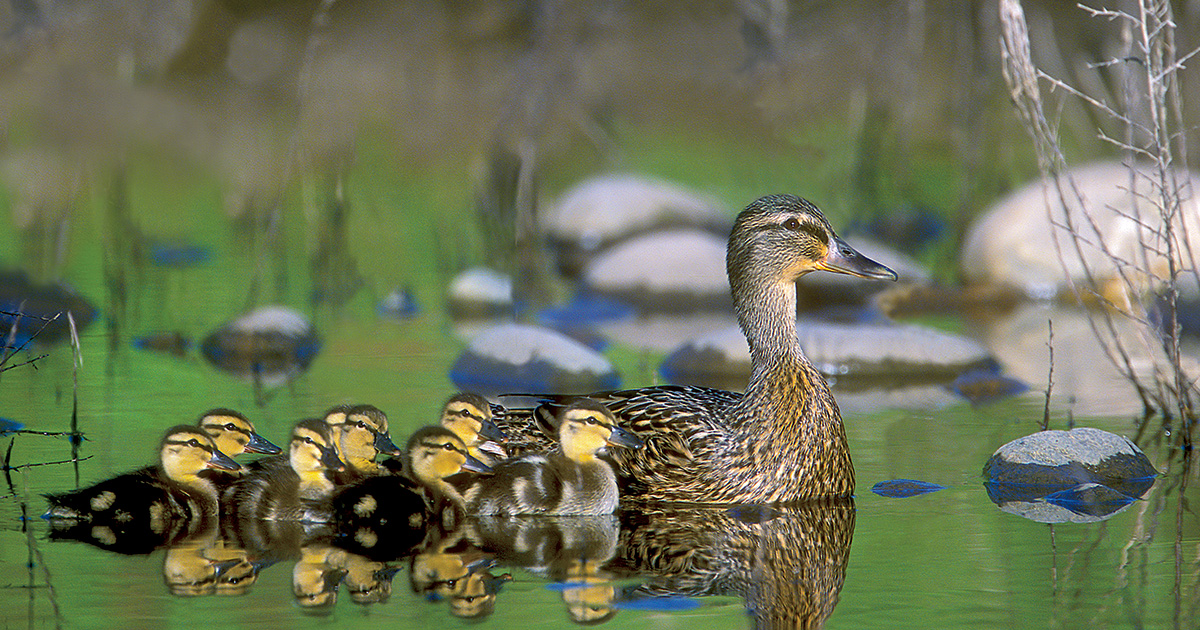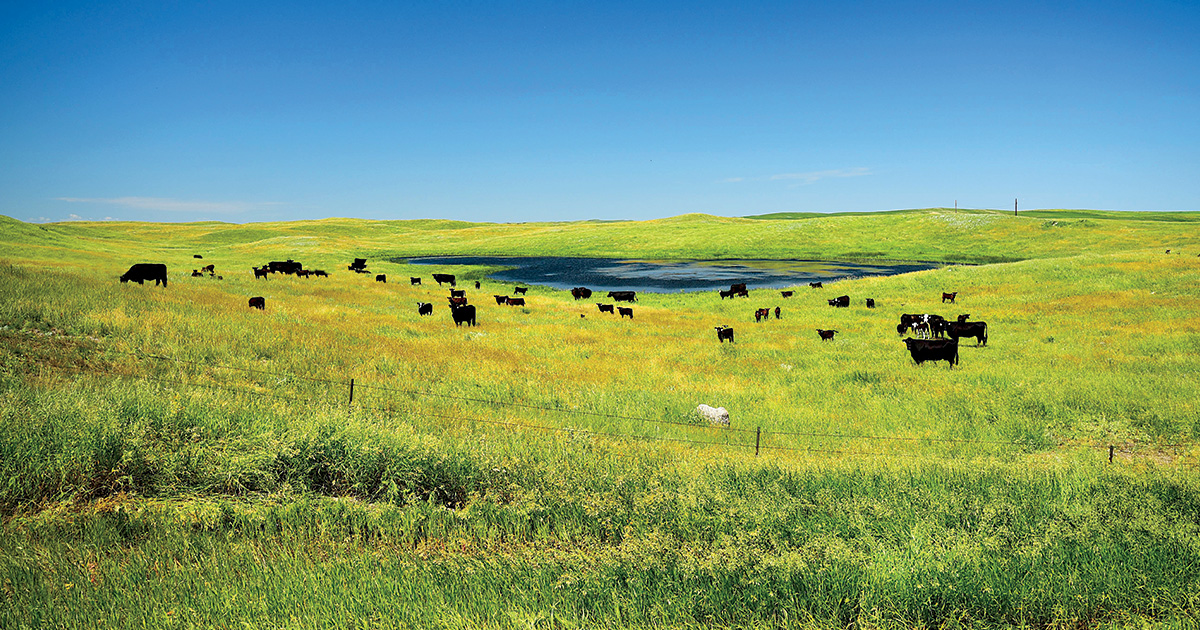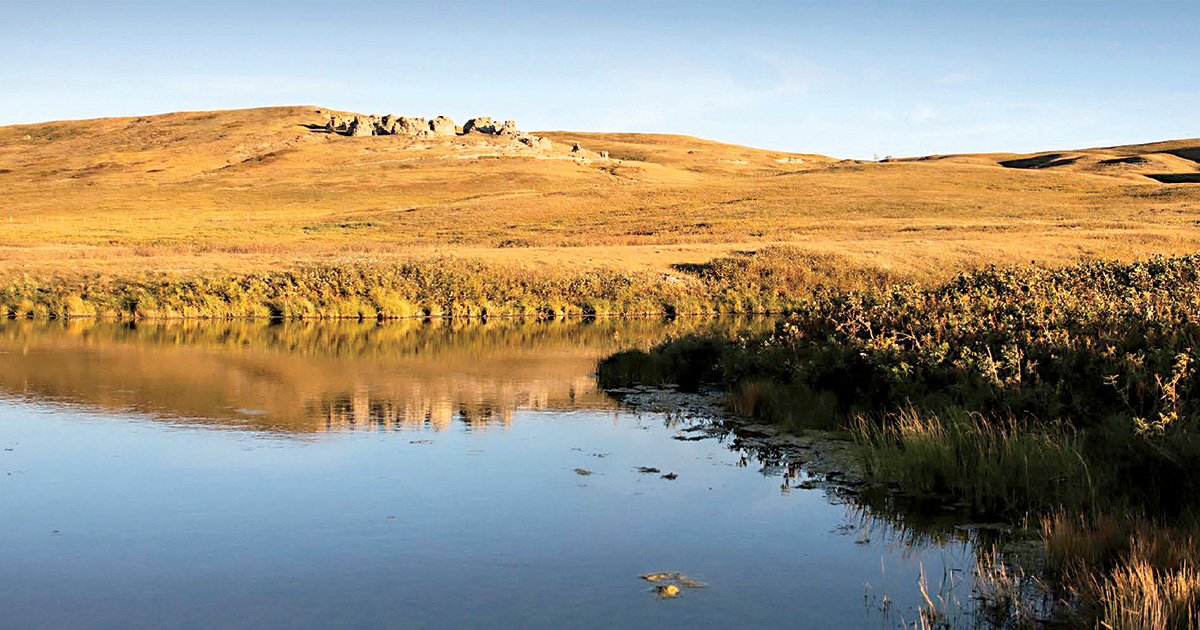Conservation: DU’s Deep Prairie Roots
Ducks Unlimited began its work in the Prairie Pothole Region 87 years ago, and this landscape remains its highest-priority conservation area
Ducks Unlimited began its work in the Prairie Pothole Region 87 years ago, and this landscape remains its highest-priority conservation area
By Jennifer Boudart

The Prairie Pothole Region supports more than half of North America’s breeding ducks, but the continuing loss of wetlands and grasslands threatens the area’s future.
The Prairie Pothole Region (PPR) is deeply entwined with Ducks Unlimited’s history. In fact, this landscape—nicknamed the Duck Factory for its importance to breeding waterfowl—has been at the heart of DU’s mission from the beginning. The first shovels to move dirt on behalf of the ducks were planted in prairie soils around Big Grass Marsh, northwest of Winnipeg, Manitoba.
The decision to deliver that inaugural project on the prairies—specifically, the Canadian portion of the PPR—was a very deliberate one, informed by the latest science. In fact, the plans were drawn up following a groundbreaking survey that had been conducted by four individuals who would later become DU’s founders: Joseph P. Knapp, John C. Huntington, Arthur M. Bartley, and Ray E. Benson. Concerned about the impacts of historic drought on the continent’s waterfowl populations and, consequently, their treasured hunting traditions, they launched an effort to put water back on the landscape for breeding ducks. To better understand where to direct those efforts, they organized a first-of-its-kind survey—conducted from both the air and the ground—of waterfowl in key breeding areas. They called this monumental survey the 1935 International Wild Duck Census.
The results painted a clear picture: The majority of breeding ducks settle each year in Prairie Canada, and that’s where the work should start. Furthermore, a new organization would be needed to raise funds in the United States to support that work. Ducks Unlimited Inc. was officially founded on January 29, 1937, in Washington, DC, and DU Canada was established a few months later in Winnipeg, Manitoba. In 1938, expansive construction projects got under way in Manitoba, Saskatchewan, and Alberta to restore water on large, previously drained wetlands. When DU began delivering conservation in the United States in 1984, the PPR was once again the initial focus.
Today, the PPR remains DU’s highest-priority conservation area due to its continental importance to breeding waterfowl. Decades of research has shown that nearly every year this region supports over half of North America’s breeding ducks. It’s also known that factors that influence waterfowl reproduction, such as nest success, brood survival, and hen survival, have the greatest impact on waterfowl populations. Ensuring healthy numbers of ducks requires conserving a healthy base of the birds’ key breeding habitats, specifically small “pothole” wetlands tucked into grasslands across the prairies.

DU works closely with farmers, ranchers, and other partners on the prairies to implement voluntary conservation programs that provide habitat for wildlife.
To help conserve these vital habitats, DU works closely with farmers, ranchers, and other private landowners, who among them own 90 percent of the land on the prairies. Voluntary conservation easements and revolving land programs are two important tools used on both sides of the border. Conservation easements permanently protect wetlands and grasslands on private lands while still allowing some farming and cattle grazing. Revolving land programs make money available for DU to purchase land with the intention of selling it after habitat has been restored and conservation easements have been secured, often as desirable and much-needed grazing land for local cattle ranchers.
Landowners who aren’t interested in a conservation easement or sale of land but who wish to practice conservation can still partner with DU on various working lands programs. In Canada, these include forage conversion programs, tenure agreements on rangeland or grassland, and extension programs to help landowners be more cost-effective and more sustainable in their operations.
In the United States, DU’s Soil Health Program helps producers integrate regenerative agriculture practices into their operations, primarily through participation in Farm Bill programs administered by the USDA’s Natural Resources Conservation Service. DU and its partners provide financial and technical support for practices such as reducing disturbance in cropping systems, restoring wetlands and grasslands, and installing rotational livestock grazing infrastructure.
DU’s work throughout the PPR continues to be guided by extensive research that evaluates how to best support conservation programs on the landscape. Areas of study range from understanding effects of climate change to identifying factors that affect brood survival to quantifying ecosystem services provided by DU’s work. Cross-border cooperation between the US and Canada continues to be a hallmark of both DU organizations.
“The planning is very seamless,” says Dr. Johann Walker, director of operations in the Great Plains Region. “The basic philosophy is that the ducks don’t see the border and neither do we. We work together regularly on planning conservation and sharing ideas, and that collaboration ensures that we can keep the table set for breeding ducks from Edmonton, Alberta, to Des Moines, Iowa.”
Of course, this cooperation also involves outside partners. Through the Association of Fish and Wildlife Agencies Fall Flights program, state wildlife agencies financially support conservation work across Canada, where most of North America’s waterfowl are raised. Fall Flights hit a historic milestone in 2023, when every state in the Lower 48 participated for the first time. State contributions are matched by DU, leveraged to secure North American Wetlands Conservation Act (NAWCA) grants, and then supplemented by investments from Canadian partners. Last year, $5.16 million in contributions from state wildlife agencies generated roughly $26.8 million for conservation. To date, states have contributed more than $116 million through the Fall Flights program, which has helped to conserve more than 6.6 million acres of waterfowl breeding habitat across Canada.
DU is also leading the way in prairie conservation through its engagement in federal policies such as the US Farm Bill and NAWCA, as well as state and provincial policies that provide conservation funding like the North Dakota Outdoor Heritage Fund. “We want to amplify enthusiasm and appreciation for grasslands and wetlands among farmers, ranchers, constituents, voters, and legislators,” says Ryan Taylor, DU’s public policy director for North Dakota, South Dakota, and Montana. “Whether it’s state-based dedicated funding, the federal duck stamp program, or NAWCA, we work to ensure these dollars provide the greatest possible return on the investment for wildlife, people, and local communities.”
At the end of the day, Walker says, relationships with all stakeholders involved in conservation are the keys to DU’s success on the prairies and across the continent. “All these relationships we have—with landowners, other conservation entities, donors, and volunteers—have helped us become a leader for delivering conservation on private lands in the PPR.”
But Walker says now’s not the time for resting on laurels. “Our vision is to fill the skies with waterfowl today, tomorrow, and forever, and that’s simply not possible without intact prairie landscapes. The productivity of this iconic landscape for breeding ducks continues to be threatened by grassland loss and wetland drainage. We have to do everything we can to maintain and increase the region’s production capacity. There is no backup plan. There is no other Prairie Pothole Region.”

DU Canada secured its largest-ever conservation easement in 2023—on the McIntyre Ranch in Alberta—through a partnership with the Nature Conservancy of Canada and the Thrall family, who own the property. The parcel totals 55,000 acres and is one of the largest blocks of unbroken prairie left in Canada.
Ducks Unlimited uses cookies to enhance your browsing experience, optimize site functionality, analyze traffic, and deliver personalized advertising through third parties. By continuing to use this site, you agree to our use of cookies. View Privacy Policy